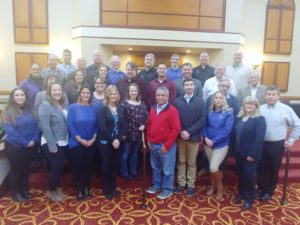President’s Message
On February 6th, Fire Safety Consultants Inc., hosted our annual all employee meeting. We find it extremely important to review, appreciate and celebrate our team and their accomplishments. Thank you to our clients and customers for supporting us while our office was closed for the afternoon. We are very excited about this year and our future!
Here are some of the highlights from our annual employee meeting.
- Our parent company, PSI presented insights on the company’s growth, highlighting each division and the strength of working together.
- We celebrated new staff who joined us in this past year and celebrated milestone awards, including four staff with over 15 years of continued service as well as new level of certifications achieved.
- The team shared investments in marketing by highlighting our new trade show display, active participation in conferences, association meetings and seminars presented across the world.
As we look ahead this year, our team discussed integrating our offices into a seamless work environment beginning with a new cloud-based phone system to be installed in the second quarter. We also looked forward to completing the upgrade of all our computers with the newest operating system and software available.
We are excited about continually training our staff, enhancing our systems and seamlessly integrating our offices to serve you better.
Marijuana Growing and Processing Facilities Part 2 – Code Requirements
Winter FSCI Newsletter Follow-up
As discussed in the FSCI Winter Newsletter, the marijuana (cannabis) industry is growing exponentially across North America. The highly purified oils collected through the extraction process can be used for many Marijuana Infused Products (MIP). As discussed in 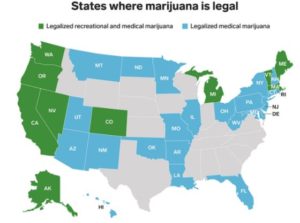 this previous article, Canada recently legalized marijuana for medical and recreational use, and in the US, many states have legalized marijuana for medical use and many of the same states for recreational use. This map, created in late 2017, is already outdated as more states have moved to some form of legalization. The industry’s extreme growth rate was slightly reduced at the end of 2018, to an annualized rate of 26% over the next 3 years.
this previous article, Canada recently legalized marijuana for medical and recreational use, and in the US, many states have legalized marijuana for medical use and many of the same states for recreational use. This map, created in late 2017, is already outdated as more states have moved to some form of legalization. The industry’s extreme growth rate was slightly reduced at the end of 2018, to an annualized rate of 26% over the next 3 years.
In the previous article we discussed the use and storage of hazardous materials in the processing (extraction) of the marijuana plant material essential oils (cannabinoids and terpenes). In this article we will explore the code requirements based on the 2018 edition of the NFPA 1 Fire Code, Chapter 38, as well as the referenced standards. The 2018 IFC, Chapter 39, addresses Processing and Extraction Facilities with similar requirements. Another chapter within the IFC which applies to grow facilities would be Chapter 26, “Fumigation and Insecticidal Fogging”. Both the Fire Code, Chapter 38, and IFC, Chapter 39, are new in the 2018 editions, and apply to new as well as existing facilities.
Current Fire Code Addresses the Industry
The “typical” marijuana complex includes vast grow facilities where plants are grown and cared for, and marijuana processing facilities. The grow facilities are large greenhouses, often with far more sophisticated 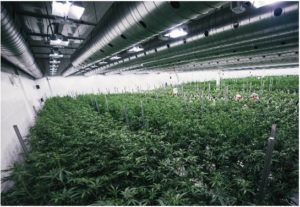 lighting and ventilation systems. Processing facilities may look somewhat like laboratories. However, according to NFPA 1, the hazardous processes and amount of production would require them to be classified as a specific use group, dependent upon the actual processes and hazards present.
lighting and ventilation systems. Processing facilities may look somewhat like laboratories. However, according to NFPA 1, the hazardous processes and amount of production would require them to be classified as a specific use group, dependent upon the actual processes and hazards present.
Code Compliance for Grow Facilities
A couple of fundamental issues to be addressed for grow buildings are found at the beginning of Chapter 38. Grow buildings are required by NFPA 1 to be protected with an approved fire suppression system per Chapter 13 and the means of egress must comply with Chapter 14 requirements, including exit access and signage, due to maximization of spaces for growing plants, and special locking arrangements due to security concerns.
Most grow buildings include a complex arrangement of light fixtures in a controlled environment that can place a strain on the electrical system. Ventilation is often required for these light fixtures. Additionally, complex ductwork can create challenges for designers and overhead hazards for firefighters. Where fumigation and pesticides are used within a facility, several issues must be addressed including:
- hazards of the particular fumigants and/or pesticides used (eg. flammable, toxic, etc.)
- sources of ignition
- notification of occupants and fire departments
- posting warning signs
- watch personnel
- controlling escape of any hazardous materials from the building or area
- venting and restoration of a safe environment
- approval to occupy the space
Code Compliance for Processing and Extraction Facilities
NFPA 1 also addresses where processing and extraction activities take place. Various hazardous materials are used in the process of extracting oils and fats including flammable/combustible liquids, LPG, and non-flammable gases, which includes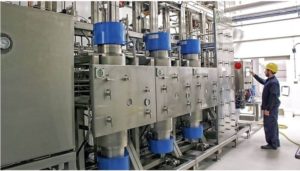 asphyxiants which are considered solvents by the code. The process of extracting these oils and fats by the use of these various solvents results in the recovery of 80% – 95% of the solvents used in the removal process.
asphyxiants which are considered solvents by the code. The process of extracting these oils and fats by the use of these various solvents results in the recovery of 80% – 95% of the solvents used in the removal process.
Extraction rooms must be constructed per the applicable building code and NFPA 1, including the required fire rated separation of rooms or areas dependent upon the type of solvent used. Processing areas cannot be located in buildings containing any of the following occupancy types:
- assembly
- educational
- day care
- health care
- ambulatory health care
- residential board and care
- residential
- detention and correctional facilities
For other than CO2 and non-hazardous extraction processes, the marijuana extraction equipment and process room must be of noncombustible construction containing only the extraction process. There are specific requirements for means of egress from these rooms including at least one exit access door which must comply with the following:
- swing in the direction of egress travel
- provided with a self-closing or automatic closing device
- equipped with panic or fire exit hardware
The code requires that the extraction process must be continuously attended to by properly trained staff, unless specifically approved by the fire code official. Staff shall receive documented training in the following areas:
- extraction process including proper, safe operation of all equipment
- transfer of hazardous materials including SDS for all products
- emergency procedures
Proper signage must be displayed identifying hazards within each room or area per NFPA 704, including warning signage throughout the facility as required by the fire code official.
All equipment related to the extraction or other hazardous processes must comply with applicable building, fire and other codes, as well as referenced standards, for both new and existing rooms or areas.
NFPA 1 references several related chapters as well as other NFPA codes and standards including:
- NFPA 12, 13, 17 and 2001 – various fire suppression systems
- NFPA 30 – Flammable and Combustible Liquids Code
- NFPA 45 – Fire Protection for Laboratories
- NFPA 58 – Liquefied Petroleum Gas
- NFPA 70 – National Electrical Code
- NFPA 90A – Standard for A/C and Ventilating Systems
- NFPA 91 – Exhaust System Air Conveying of Vapors, Gases, Mists and Noncombustible Particulates Solids
All equipment must be listed and approved. If not listed, a registered design professional, approved by the fire code official, must provide supporting documentation and a technical report demonstrating compliance. This includes the final inspection and approval of the processing equipment installation.
In any room or area where an explosive condition exists, all ancillary equipment and other equipment used in these areas, must be approved for use and listed for use in the conditions present. This can include items such as ovens and other heating devices, as well as refrigeration equipment used to store or cool hazardous materials.
There are specific requirements that relate to each extraction process based primarily on the hazardous material used in the process. These hazardous processes include materials such as LPG, flammable/combustible liquids and inert gas. Each of these has specific requirements related to the hazards. The following is a brief list of requirements based each hazardous process.
LPG Gas Extraction Process
- All LPG equipment and piping must comply with NFPA 58 including transfilling operations
- An approved exhaust system installed per applicable codes and standards such as NFPA 91 in the room or area that must be interlocked with process equipment operation
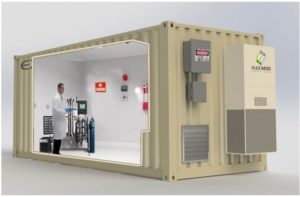
- All LPG extraction operations must be performed using an approved chemical fume hood or enclosure that must be interlocked with process equipment operation
- An approved gas detection system with alerting at 25% or lower of LEL/LFL continuously powered
- LPG containers cannot be stored in the extraction room or area
- Compliance with electrical requirements per NFPA 70 including bonding and grounding, proper electrical installations inside of the room and hood/enclosure, emergency power system supplying lighting, ventilation and the detection system
- An approved fire suppression system for the protection of the gases and hazards in the process, such as fire sprinkler, clean agent, dry chemical systems
Flammable/Combustible Liquids Extraction Process (heated processes or using more than 16 ounces of liquids)
- An approved exhaust system installed per applicable codes and standards such as NFPA 91 in the room or area that must be interlocked with process equipment operation
- All flammable/combustible liquid extraction operations including dispensing or transferring of liquids between containers must be performed in an approved chemical fume hood or an enclosure per NFPA 45
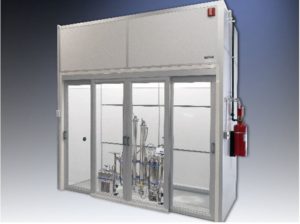
- Compliance with electrical requirements per NFPA 70 including bonding and grounding, proper electrical installations inside of the room and hood/enclosure, emergency power system supplying lighting, ventilation and the detection system
- Heating cannot be performed by open flame devices
- The storage, use and dispensing of flammable and combustible liquids must comply with NFPA 1 requirements
Carbon Dioxide Gas Extraction Process
- Carbon dioxide cylinders must be properly protected from damage and secured from falling
- Approved carbon dioxide detector(s) must be installed in the extraction room set to alarm at or below 5000 ppm
- Equipment pressure relief and blow-off valves must be piped to the exterior of the building
In Closing
Parts 1 and 2 of this article have been an overview of the marijuana processing industry and the NFPA 1 requirements for compliance. As previously stated, the industry is evolving rapidly, as is the extraction processes and equipment used. From a fire safety perspective, the building and fire codes will continue to address these hazards, but often are lagging behind developments within in the industry. Using the enforcement authority in NFPA 1, and other codes and standards, will allow the fire code official to work with design professionals and industry experts to assure safe design, installation and operation of these facilities.
-Keith S Frangiamore, CFPS
Employee Spotlight
Fred Hoelger
Fred Hoegler has been with Fire Safety Consultants, Inc. for 10 years now. He came to us following 28 years in the fire service. Fred’s last assignment was as a Deputy Fire Chief with the Palatine Fire Department. His career included progressing through the ranks of firefighter, firefighter/paramedic, lieutenant, shift captain and training captain. Additionally, Fred spent more than 10 years in the fire prevention bureau. 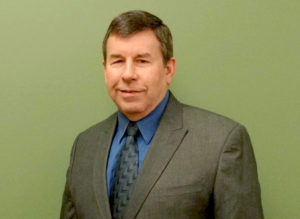
Fred’s duties at FSCI include supervising a combination of over 14 full-time fire protection plan reviewers and part-time field inspectors, as well as closely interacting with FSCI’s clients when they have code comments or concerns. Fred’s certifications include having his NICET II in Fire Alarms and Water-Based Systems, as well as Fire Prevention Officer 1 and Inspector III. When Fred has some free time, he enjoys working on projects around the house and spending time with his grandson.
Employee News
Fire Safety Consultants, Inc. was happy to revel in our accomplishments by celebrating a night out with our employees as well as some key staff at PSI. We spent the evening at  Pinstripes in South Barrington enjoying some great food and having fun with a bocce tournament. Of course, none of us suspected any type of shenanigans when we all found out Keith Frangiamore’s team won the tournament!
Pinstripes in South Barrington enjoying some great food and having fun with a bocce tournament. Of course, none of us suspected any type of shenanigans when we all found out Keith Frangiamore’s team won the tournament!
We would also like to congratulate Michael Carnduff for receiving his NICET Level I: Water-Based System Layouts certification on February 13th and Scott Kunzie for receiving his NICET Level 2: Fire Alarm Systems on March 21st.
Little Known Facts
Kitchen Wet Chemical Suppression Systems
In July of 2018, Ansul has introduced a new bulletin allowing for a third overlapping protection option. This new option is specifically designed for complete protection of a 10 ft. hood with two manifolded 3.0 gal tanks. Three flow points are designated for protection of the plenum and duct and ten flow points are provided for protection of appliances under the hood. Similar to option #2, option #3 utilizes 245 nozzles for “end of zone” protection spaced a maximum of 11.5 inches from each end and 260 nozzles for zone protection spaced a maximum of 22.5 inches on center. However, option #2 allows a maximum of 6 flow points per 3.0 gal tank and would not be able to protect a 10 ft. hood system with two tanks if the duct required 2 flow points to protect it. Additional design limitations for the new overlapping protection option are listed in the bulletin with many referencing back to the existing option #2. Requirements for appliance protection and zone specifications are already found in the installation manual. This new option is sure to make a great addition to the Ansul overlapping protection line up.
Hannah Rodriguez, Fire Protection Consultant
NFPA 13 – Air Venting
Air venting is an efficient way on wet pipe sprinkler systems to reduce corrosion and microbial activity. New to the 2016 edition of NFPA 13, Section 7.1.5 requires a single air vent to be installed for each wet sprinkler system utilizing metallic pipe. The purpose of air venting is to remove air that is trapped when the system is filled. Not all of the trapped air will be exhausted while venting the system. More than one vent may be installed to limit the amount of trapped air in a system, but only a single vent is required. The vent connection to the system should be located in the top of horizontal piping at a high point in the system. The vent can also be effectively located off of the side of a riser at a high point in the system. The system should be vented every time the system is filled.
Section 7.1.5 states that the air vent must conform to section 8.16.6. Section 8.16.6 discusses the methods that can be used for air removal from the system. These methods include: A manual valve of a minimum size of ½”; an automatic air vent; or, other approved means. A manual air venting valve should be located in an area that is accessible. Automatic air valves are not required to comply with the accessibility requirements of manual air venting valves; however, it is recommended that they are located over areas without ceilings, above a lay-in ceiling, or above an access panel.
Michael Carnduff, Fire Protection Consultant
NFPA 72 – Can you hear me know? Designing for Acoustically Challenging Areas
Emergency Voice Alarm Communication (EVAC) systems must meet public mode, minimum decibel levels, as outlined in Chapter 18 of NFPA 72, for their alert tones. Additionally, the system must also produce an intelligent message acceptable to the authority having jurisdiction. EVAC systems are typically required in Assembly occupancies with occupancy loads of 1,000 or more, Educational uses of more than 100 occupants, and high-rises. A least one program is available which a fire alarm designer can use to design an intelligible voice system. The program designs systems using commercially available and listed loudspeakers to achieve messages which are understandable to building occupant.
The 2016 edition of NFPA 72, added a provision which recognizes that listed loudspeakers may not be capable of providing intelligible voice in notification zones under certain circumstances. Section 24.3.1.2 states, “Where no listed loudspeaker exists to achieve the intelligibility requirements of the Code for a notification zone, non-listed loudspeakers shall be permitted to be installed to achieve the intelligibility for that notification zone.” Keep in mind, if the non-listed loudspeaker was to fail, it must not disrupt the operation of the fire alarm system.
Another factor to be considered with an EVAC system is the use of the typically provided hand-held microphone. Users of systems that have a microphone for live voice announcements shall be provided with posted instructions for the correct use of the microphone.
Susie Gardner, Fire Protection Consultant
Seminars
Stay up to date on the latest Fire, Building and Life Safety code changes and equipment by attending one of our seminars. FSCI is teaching seminars throughout the United States, led by our experienced staff of Matt Davis, Keith Frangiamore, Brent Gooden, George Michehl & Warren Olsen. Whether you are a Contractor, Architect, Technician, Engineer or an Authority Having Jurisdiction, each seminar is full of practical insights and first-hand experiences to help you comply with applicable codes and standards. FSCI can also provide custom seminars at your location. Be sure to check out our schedule of upcoming seminars on our website. Contact us to learn more by emailing [email protected] or by calling our office at (847) 697-1300.

